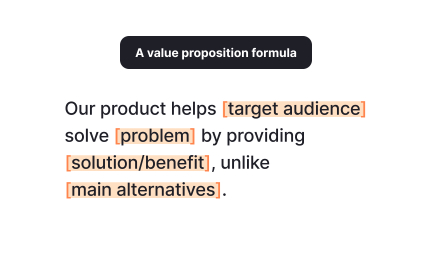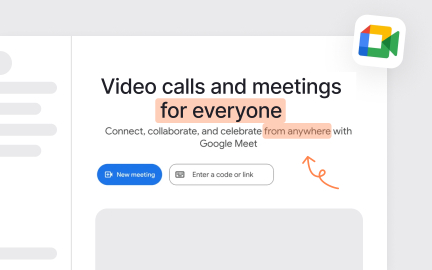Unique Selling Proposition (USP)
A unique selling proposition (USP) explains what makes a product different and better than alternatives in a way that speaks to user needs.
What is Unique Selling Proposition?
Your product struggles in a sea of similar alternatives because you describe features rather than articulating what makes you uniquely valuable, leading to commodity competition where customers choose based on price rather than distinctive value only you provide.
Most companies list benefits without identifying what's truly unique about their offering, missing that Unique Selling Proposition (USP) must be something only you can claim, not just good things about your product that competitors could also say.
A Unique Selling Proposition is the single, specific benefit that makes your product or service stand out from every alternative, clearly stating why customers should choose you over anyone else through distinctive value only you deliver.
Companies with strong USPs achieve 75% better conversion rates, command 40% higher prices, and build significantly stronger market positions because customers understand exactly why they're different rather than comparing generic feature lists.
Think about how FedEx owned "When it absolutely, positively has to be there overnight" or how Domino's dominated with "30 minutes or it's free," proving USPs create categories rather than competing in existing ones.
Why Unique Selling Propositions Matter for Market Success
Your marketing messages fall flat because they could describe any competitor's product, leading to confused customers who can't distinguish between options and default to lowest price when uniqueness isn't clear.
The cost of lacking clear USP compounds through every lost sale and price pressure. You compete on price rather than value, struggle to justify premiums, waste marketing on unclear messages, and eventually become commoditized when customers see no unique reason to choose you.
What effective USPs deliver:
Better competitive differentiation and positioning because USPs claim territory competitors can't occupy rather than competing for same benefits everyone promotes.
When USPs work well, customers self-select based on unique value rather than comparing features that look identical across options.
Enhanced pricing power and margins through distinctive value that justifies premiums rather than commodity pricing when uniqueness isn't established.
Improved marketing efficiency and focus because USPs guide all messaging rather than scattered benefits that confuse rather than compel.
Stronger customer loyalty and advocacy as USPs attract customers who value your uniqueness rather than price shoppers without allegiance.
Clearer product development priorities because USPs define what to enhance versus dilute through feature expansion without strategic focus.
Advanced Unique Selling Proposition Approaches
Once you've mastered basic USPs, implement sophisticated differentiation approaches.
Multi-Level USP Architecture: Create USPs for company, products, and features rather than single statement, building coherent differentiation story.
Dynamic USP Evolution: Evolve USP as market changes rather than static positioning, maintaining uniqueness as competitors adapt.
Emotional USP Development: Build USPs on emotional benefits beyond functional rather than pure logic, creating deeper differentiation.
USP-Driven Business Model: Design entire business around USP rather than just marketing message, ensuring genuine uniqueness competitors can't easily copy.
Step 1: Analyze Competitive Positioning Honestly (Week 1)
Map what every competitor claims to understand available positioning rather than assuming uniqueness without verification, finding white space others haven't claimed.
This creates USP foundation based on actual differentiation rather than wishful thinking about uniqueness that isn't actually unique.
Step 2: Identify Your Distinctive Capabilities (Week 1-2)
Discover what you do differently or better that matters to customers rather than internal capabilities without market relevance, finding genuine differentiation.
Focus capability assessment on customer value rather than technical features, ensuring USP resonates rather than impressing without compelling.
Step 3: Connect Uniqueness to Customer Desires (Week 2-3)
Match your distinctive capabilities to intense customer needs rather than unique features seeking problems, ensuring USP addresses real market demand.
Balance uniqueness with relevance to avoid being different without being better in ways customers actually care about.
Step 4: Craft Clear, Memorable Statement (Week 3-4)
Distill USP into single sentence customers can remember and repeat rather than paragraph explanations, creating clarity that sticks.
Step 5: Test and Validate with Market (Week 4-5)
Verify USP resonates with actual customers rather than internal agreement, refining based on market reaction rather than committee consensus.
This ensures USPs drive real differentiation rather than clever slogans without market impact or competitive advantage.
If USPs don't improve competitive position, examine whether they're truly unique rather than generic benefits with unique wording.
The Problem: USPs that list benefits without uniqueness, saying things like "high quality" or "great service" any competitor could claim.
The Fix: Add "only we" test to every claim rather than generic benefits, ensuring USP is genuinely unique not just true.
The Problem: Complex USPs trying to communicate multiple unique benefits, diluting impact through kitchen sink approach to differentiation.
The Fix: Focus on single most powerful differentiator rather than comprehensive uniqueness, accepting trade-off for clarity and memorability.
The Problem: USPs based on temporary advantages like "first" or "cheapest" that competitors quickly match, losing uniqueness over time.
The Fix: Build USP on sustainable differentiation rather than temporal advantages, finding uniqueness in approach not just current position.
Create Unique Selling Propositions that establish defendable market positions rather than temporary slogans without lasting differentiation.
Recommended resources
Courses

UX Research

Enhancing UX Workflow with AI






